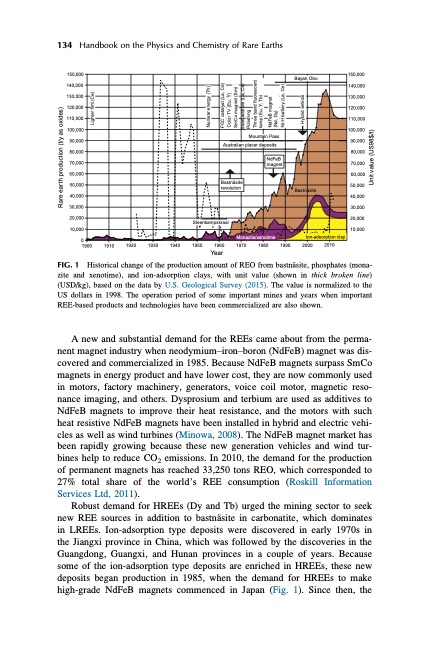
PDF Publication Title:
Text from PDF Page: 170
134 Handbook on the Physics and Chemistry of Rare Earths 150,000 140,000 130,000 120,000 110,000 100,000 90,000 80,000 70,000 60,000 50,000 40,000 30,000 20,000 10,000 0 1900 1910 150,000 140,000 130,000 120,000 110,000 100,000 90,000 80,000 70,000 60,000 50,000 40,000 30,000 20,000 10,000 Bayan Obo Australian Mountain placer dep Pass osits NdFeB magnet Ba stnäsite revolution Bastn äsite St eenkampskraal Monazite/xenotime Ion-adsorption clay 1920 1930 1940 1950 1960 Year 1970 1980 1990 2000 2010 FIG. 1 Historical change of the production amount of REO from bastnäsite, phosphates (mona- zite and xenotime), and ion-adsorption clays, with unit value (shown in thick broken line) (USD/kg), based on the data by U.S. Geological Survey (2015). The value is normalized to the US dollars in 1998. The operation period of some important mines and years when important REE-based products and technologies have been commercialized are also shown. A new and substantial demand for the REEs came about from the perma- nent magnet industry when neodymium–iron–boron (NdFeB) magnet was dis- covered and commercialized in 1985. Because NdFeB magnets surpass SmCo magnets in energy product and have lower cost, they are now commonly used in motors, factory machinery, generators, voice coil motor, magnetic reso- nance imaging, and others. Dysprosium and terbium are used as additives to NdFeB magnets to improve their heat resistance, and the motors with such heat resistive NdFeB magnets have been installed in hybrid and electric vehi- cles as well as wind turbines (Minowa, 2008). The NdFeB magnet market has been rapidly growing because these new generation vehicles and wind tur- bines help to reduce CO2 emissions. In 2010, the demand for the production of permanent magnets has reached 33,250 tons REO, which corresponded to 27% total share of the world’s REE consumption (Roskill Information Services Ltd, 2011). Robust demand for HREEs (Dy and Tb) urged the mining sector to seek new REE sources in addition to bastnäsite in carbonatite, which dominates in LREEs. Ion-adsorption type deposits were discovered in early 1970s in the Jiangxi province in China, which was followed by the discoveries in the Guangdong, Guangxi, and Hunan provinces in a couple of years. Because some of the ion-adsorption type deposits are enriched in HREEs, these new deposits began production in 1985, when the demand for HREEs to make high-grade NdFeB magnets commenced in Japan (Fig. 1). Since then, the Rare earth production (t/y as oxides) Unit value (US98$/t) Lighter flint (Ce) Nuclear energy (Th) FCC catalyst (La, Ce) Color TV (Eu, Y) SmCo magnet (Sm) Steel additive (La, Ce) Polishing Three band fluorescent lamp (Eu, Y, Tb) NdFeB magnet (Nd, Dy) Ni-H battery (La, Ce) Hybrid vehiclePDF Image | HANDBOOK ON THE PHYSICS AND CHEMISTRY OF RARE EARTHS

PDF Search Title:
HANDBOOK ON THE PHYSICS AND CHEMISTRY OF RARE EARTHSOriginal File Name Searched:
Chemistry-Rare-Earths-49.pdfDIY PDF Search: Google It | Yahoo | Bing
Sulfur Deposition on Carbon Nanofibers using Supercritical CO2 Sulfur Deposition on Carbon Nanofibers using Supercritical CO2. Gamma sulfur also known as mother of pearl sulfur and nacreous sulfur... More Info
CO2 Organic Rankine Cycle Experimenter Platform The supercritical CO2 phase change system is both a heat pump and organic rankine cycle which can be used for those purposes and as a supercritical extractor for advanced subcritical and supercritical extraction technology. Uses include producing nanoparticles, precious metal CO2 extraction, lithium battery recycling, and other applications... More Info
| CONTACT TEL: 608-238-6001 Email: greg@infinityturbine.com | RSS | AMP |